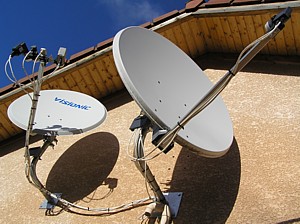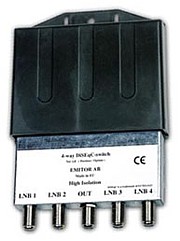Mise à jour du 4/5/11.
La
Réception de TV et Radio par le Satellite.
Television
and Radio Reception by
Satellite.
Quoi
de neuf pour la
réception par satellite, qu'est-ce que je peux
recevoir "gratuitement" et comment faire?
What's
new in satellite reception, what
programmes can I get for
"free" and how can I get them?
3.
Aligner les paraboles et raccorder les boîtiers/Aligning
the dishes and connecting up the
boxes.
L'alignement des paraboles fixes est beaucoup plus façile
que celle des paraboles motorisées.
Le site suivant est très utile pour trouver les informations générales.
Télé Satellite Dossiers Techniques
Si ça paraît compliqué ne vous inquiétez pas!
1. Vous avez besoin de connaître le vrai sud. Pour cela utilisez l'ombre du soleil à midi GMT. Il sera plein nord.
CET = GMT +2 en été et GMT +1 en hiver.
2. Vous devez connaître votre longitude et latitude. Simplement tapez le nom de votre ville et le pays sur le site de UNIVERSIMMEDIA.
Pour Astra 28.2°E (pour moi parabole 1), ou tout autre satellite que vous voulez utiliser, allez sur le tableau ICI et remplissez les valeurs de latitude et longitude que vous venez de trouver sur Universimmedia ou consultez ce tableau (pour la France uniquement).
Réglez l'inclinaison de la parabole à l'aide des graduations sur les fixations!
Orientez la parabole sur l'azimut obtenu auparavant!
Allumez le récepteur correspondant et tournez doucement l'antenne jusqu'à la réception du signal, avec un peu de chance!
Avec un pointeur satellite électronique vous allez augmenter vos chances considérablement et ça coûte moins de 20 euros.
Sinon, il faut réessayer en changeant légèrement en plus ou en moins l'élévation.
Quand vous obtenez le signal vous pouvez optimiser les deux réglages.
Ensuite, il faut optimiser la polarisation en tournant légèrement le LNB dans sa fixation jusqu'à l'obtention du signal maximal. Ce réglage est très important!
Pour AB3 (pour moi parabole 2) c'est la même méthode, il suffit de régler l'élévation et azimut aux valeurs pour votre département marquées dans le tableaux comme précédemment
Comme avant si vous n'avez pas de signal au premier coup, il faut réessayer en augmentant ou en diminuant légèrement l'élévation et faire des petits balayages en azimuth. Encore une fois, le pointeur éléctronique sera une aide précieuse!
Après obtention du signal AB3, normalement vous avez automatiquement les deux autres signaux Astra 19 et Hotbird 13. Sinon, il sera nécessaire de bouger légèrement la position des LNB ou la tête monobloc si vous utilisez un démodulateur dédié. Bonne chance!
Pour moi, les positions des satellites ont été rapidement trouvées et les graduations sur les fixations des paraboles se sont avérées assez précises. Peut être que j'ai eu de la chance!
Naturellement les expatriés britanniques cherchent à capter Astra 2d à 28.2°E. Mais les hispanophones peuvent trouver leur joie sur Hispasat 30°W, les turkophones sur Turksat 42°E et c'est la même chose pour d'autres pays. L'information est ICI.
Bien sûr, plus on s'écarte du sud, plus on risque le problème d'obstructions.
Le site suivant est très utile pour trouver les informations générales.
Télé Satellite Dossiers Techniques
Si ça paraît compliqué ne vous inquiétez pas!
1. Vous avez besoin de connaître le vrai sud. Pour cela utilisez l'ombre du soleil à midi GMT. Il sera plein nord.
CET = GMT +2 en été et GMT +1 en hiver.
2. Vous devez connaître votre longitude et latitude. Simplement tapez le nom de votre ville et le pays sur le site de UNIVERSIMMEDIA.
Pour Astra 28.2°E (pour moi parabole 1), ou tout autre satellite que vous voulez utiliser, allez sur le tableau ICI et remplissez les valeurs de latitude et longitude que vous venez de trouver sur Universimmedia ou consultez ce tableau (pour la France uniquement).
Réglez l'inclinaison de la parabole à l'aide des graduations sur les fixations!
Orientez la parabole sur l'azimut obtenu auparavant!
Allumez le récepteur correspondant et tournez doucement l'antenne jusqu'à la réception du signal, avec un peu de chance!
Avec un pointeur satellite électronique vous allez augmenter vos chances considérablement et ça coûte moins de 20 euros.
Sinon, il faut réessayer en changeant légèrement en plus ou en moins l'élévation.
Quand vous obtenez le signal vous pouvez optimiser les deux réglages.
Ensuite, il faut optimiser la polarisation en tournant légèrement le LNB dans sa fixation jusqu'à l'obtention du signal maximal. Ce réglage est très important!
Pour AB3 (pour moi parabole 2) c'est la même méthode, il suffit de régler l'élévation et azimut aux valeurs pour votre département marquées dans le tableaux comme précédemment
Comme avant si vous n'avez pas de signal au premier coup, il faut réessayer en augmentant ou en diminuant légèrement l'élévation et faire des petits balayages en azimuth. Encore une fois, le pointeur éléctronique sera une aide précieuse!
Après obtention du signal AB3, normalement vous avez automatiquement les deux autres signaux Astra 19 et Hotbird 13. Sinon, il sera nécessaire de bouger légèrement la position des LNB ou la tête monobloc si vous utilisez un démodulateur dédié. Bonne chance!
Pour moi, les positions des satellites ont été rapidement trouvées et les graduations sur les fixations des paraboles se sont avérées assez précises. Peut être que j'ai eu de la chance!
Naturellement les expatriés britanniques cherchent à capter Astra 2d à 28.2°E. Mais les hispanophones peuvent trouver leur joie sur Hispasat 30°W, les turkophones sur Turksat 42°E et c'est la même chose pour d'autres pays. L'information est ICI.
Bien sûr, plus on s'écarte du sud, plus on risque le problème d'obstructions.
- Page 1- INTRODUCTION
- Page 2- BESOINS
- Page 4- Réception TVHD sur un PC
- Page 5- Chaînes captées.
En pratique/In practice

Deux paraboles avec 5 LNBdont 3 avec
doubles sorties/
Two
dishes with 5 LNB's of which 3 have twin outputs.

Pointeur satellite/Satellite finder.
Commutation par moyen de deux boîtiers
diseqc 1.
/Switching
by two diserqc 1 boxes.

Boîtier diseqc 1/Diseqc 1 box.
Méthode alternative avec tête monobloc
Astra-Hotbird etcommutation par boîtier péritel/
Another
switching method with a Astra-Hotbird combined LNB and a scart box.
Le boîtier
péritel était le DUNE 51050 at around 12 euros./
The SCART controler is a DUNE 51050 12 euros environ.
Setting
up the fixed dishes is a lot easier than the motorized versions.
For general guidance the following site in French is extremely helpful.
Télé Satellite Dossiers Techniques
If it seems complicated don't worry.
1.You will need to know the position of South: use the shadow of the sun at mid-day GMT. It will point due North.
CET = GMT +2 in summer et GMT +1 in winter.
2.You will need to know your longitude and latitude.
The site here will be able to give it to you. UNIVERSIMMEDIA. Simply type in your town and country
For the Astra 28.2 satellite or any other satellite you wish to capture fill out the form HERE or consult this table (France only).
Set the elevation obtained on the dish angle graduations.
Turn your dish to the azimuth that you have just calculated.
Turn on the power and swing your dish from side to side. If you are lucky you should receive a signal. Your luck will be greatly improved with an electronic satellite pointer! If not you will have to try again with slightly different elevations. When you do get something you can optimize both azimuth and elevation.
When this is done you can optimize the polarization by turning the LNB until the signal is a maximum. This adjustment is very important. Tighten up all the bolts!
For AB3 (dish 2 for me), it's the same thing you must set the elevation and azimuth for your locality for this satellite, using the website or the table. Then, as before, if you don't get reception straight away, you will have to increase or lower the elevation slightly and to slightly swing the azimuth setting from side to side. Once again the electronic pointer will be very useful here. When you have received a signal you should be pretty near with the other two satellites, Astra and Hotbird. If you don't pick them up straight away you will need to adjust the two LNB's in turn or the combined LNB with it's dedicated demodulator. Good luck!
I must say that for myself, the satellites were quickly located, and the graduations of the dish fixtures were remarkably accurate. Perhaps I had a lucky day!
Of course British expats will want the 28.2°E group of satellites, but Spanish programmes will be found on Hispasat 30°W, Turkish on Turksat 42°E, and so on for all other countries. The information is HERE. Of course the further away from South you go, the more obstructions will be a problem!
For general guidance the following site in French is extremely helpful.
Télé Satellite Dossiers Techniques
If it seems complicated don't worry.
1.You will need to know the position of South: use the shadow of the sun at mid-day GMT. It will point due North.
CET = GMT +2 in summer et GMT +1 in winter.
2.You will need to know your longitude and latitude.
The site here will be able to give it to you. UNIVERSIMMEDIA. Simply type in your town and country
For the Astra 28.2 satellite or any other satellite you wish to capture fill out the form HERE or consult this table (France only).
Set the elevation obtained on the dish angle graduations.
Turn your dish to the azimuth that you have just calculated.
Turn on the power and swing your dish from side to side. If you are lucky you should receive a signal. Your luck will be greatly improved with an electronic satellite pointer! If not you will have to try again with slightly different elevations. When you do get something you can optimize both azimuth and elevation.
When this is done you can optimize the polarization by turning the LNB until the signal is a maximum. This adjustment is very important. Tighten up all the bolts!
For AB3 (dish 2 for me), it's the same thing you must set the elevation and azimuth for your locality for this satellite, using the website or the table. Then, as before, if you don't get reception straight away, you will have to increase or lower the elevation slightly and to slightly swing the azimuth setting from side to side. Once again the electronic pointer will be very useful here. When you have received a signal you should be pretty near with the other two satellites, Astra and Hotbird. If you don't pick them up straight away you will need to adjust the two LNB's in turn or the combined LNB with it's dedicated demodulator. Good luck!
I must say that for myself, the satellites were quickly located, and the graduations of the dish fixtures were remarkably accurate. Perhaps I had a lucky day!
Of course British expats will want the 28.2°E group of satellites, but Spanish programmes will be found on Hispasat 30°W, Turkish on Turksat 42°E, and so on for all other countries. The information is HERE. Of course the further away from South you go, the more obstructions will be a problem!
- Page 1- INTRODUCTION
- Page 2- NEEDS
- Page 4- HDTV reception on a PC.
- Page 5- Programmes picked up.